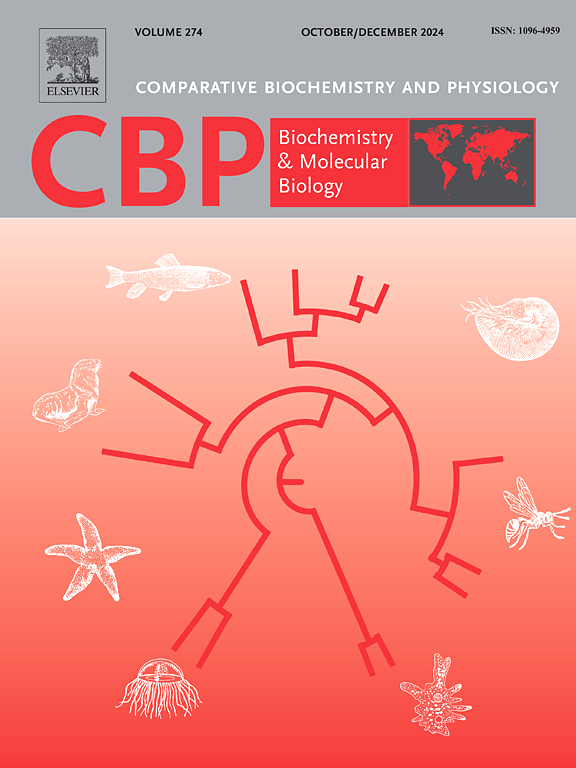太平洋白对虾(十足目,对虾科)鳃(Na+,K+)-ATP 酶的动力学特性。
IF 1.8
3区 生物学
Q4 BIOCHEMISTRY & MOLECULAR BIOLOGY
Comparative Biochemistry and Physiology B-Biochemistry & Molecular Biology
Pub Date : 2024-10-05
DOI:10.1016/j.cbpb.2024.111038
引用次数: 0
摘要
白对虾(Penaeus vannamei)原产于东太平洋,现栖息于亚洲、中美洲和南美洲的热带水域。这种底栖物种生长迅速,耐盐碱、耐高温,抗病力强。这些生理特性促使人们对其渗透调节机制进行广泛研究,包括下一代测序、转录组分析和脂质组反应。甲壳类动物的渗透和离子平衡主要由膜结合金属酶(Na+、K+)-ATPase 维持。然而,人们对各种配体如何调节凡纳米甲壳动物体内的这种酶知之甚少。在这里,我们研究了鳃(Na+、K+)-ATP 酶的动力学特征,以便从生化角度了解其调节作用。我们发现了一条约 120 kDa 的突出免疫反应带,与(Na+、K+)-ATP 酶 alpha-亚基相对应。该酶有两个 ATP 水解位点,K0.5 = 0.0003 ± 0.00002 和 0.05 ± 0.003 mmol L-1,并受到低钠离子浓度的刺激。钾离子和铵离子也能刺激酶的活性,其 K0.5 值分别为 0.08 ± 0.004 和 0.06 ± 0.003 mmol L-1。欧贝因抑制曲线表明只有一种酶同工酶,其 KI 值为 2.10 ± 0.16 mmol L-1。我们的研究结果表明,与海洋和淡水甲壳类动物相比,凡纳滨对虾(Na+, K+)-ATP 酶的动力学差异很大。我们希望我们的研究结果能加深对凡纳滨对虾鳃(Na+、K+)-ATP 酶调节的理解,并为研究对虾在不同盐度条件下的生化适应性提供有价值的工具。本文章由计算机程序翻译,如有差异,请以英文原文为准。

Kinetic properties of gill (Na+, K+)-ATPase in the Pacific whiteleg shrimp Penaeus vannamei (Decapoda, Penaeidae)
The whiteleg marine shrimp Penaeus vannamei, originally from the Eastern Pacific Ocean, now inhabits tropical waters across Asia and Central and Southern America. This benthic species exhibits rapid growth, wide salinity and temperature tolerance, and disease resistance. These physiological traits have led to extensive research on its osmoregulatory mechanisms, including next-generation sequencing, transcriptomic analyses, and lipidomic responses. In crustaceans, osmotic and ionic homeostasis is primarily maintained by the membrane-bound metalloenzyme (Na+, K+)-ATPase. However, little is known about how various ligands modulate this enzyme in P. vannamei. Here, we examined the kinetic characteristics of the gill (Na+, K+)-ATPase to get biochemical insights into its modulation. A prominent immunoreactive band of ~120 kDa, corresponding to the (Na+, K+)-ATPase alpha-subunit, was identified. The enzyme exhibited two ATP hydrolyzing sites with K0.5 = 0.0003 ± 0.00002 and 0.05 ± 0.003 mmol L−1 and was stimulated by low sodium ion concentrations. Potassium and ammonium ions also stimulated enzyme activity with similar K0.5 values of 0.08 ± 0.004 and 0.06 ± 0.003 mmol L−1, respectively. Ouabain inhibition profile suggested a single enzyme isoform with a KI value of 2.10 ± 0.16 mmol L−1. Our findings showed significant kinetic differences in the (Na+, K+)-ATPase in Penaeus vannamei compared to marine and freshwater crustaceans. We expect our results to enhance understanding of the modulation of gill (Na+, K+)-ATPase in Penaeus vannamei and to provide a valuable tool for studying the shrimp's biochemical acclimation to varying salinity conditions.
求助全文
通过发布文献求助,成功后即可免费获取论文全文。
去求助
来源期刊
CiteScore
4.60
自引率
4.50%
发文量
77
审稿时长
22 days
期刊介绍:
Comparative Biochemistry & Physiology (CBP) publishes papers in comparative, environmental and evolutionary physiology.
Part B: Biochemical and Molecular Biology (CBPB), focuses on biochemical physiology, primarily bioenergetics/energy metabolism, cell biology, cellular stress responses, enzymology, intermediary metabolism, macromolecular structure and function, gene regulation, evolutionary genetics. Most studies focus on biochemical or molecular analyses that have clear ramifications for physiological processes.

 求助内容:
求助内容: 应助结果提醒方式:
应助结果提醒方式:


